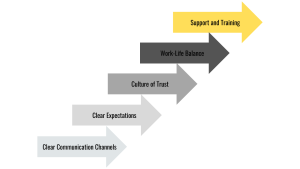Remote IT Environment: Flexibility and Productivity
Introduction The modern landscape of work has undergone a significant transformation in recent years, with remote employment becoming increasingly prevalent, especially in the...

Introduction
The modern landscape of work has undergone a significant transformation in recent years, with remote employment becoming increasingly prevalent, especially in the IT sector. The flexibility afforded by remote work has revolutionised the traditional office setup, allowing IT professionals to work from anywhere in the world. However, with this newfound flexibility comes the challenge of maintaining productivity and efficiency. In this article, we explore the dynamics of balancing flexibility and productivity in a remote IT environment, offering insights and strategies for organisations to thrive in this evolving paradigm.
Understanding the Remote IT Environment
Remote work has become a cornerstone of the IT industry, enabling professionals to collaborate and contribute to projects without the constraints of physical proximity. Whether working from home, a co-working space, or a café, remote IT professionals have the flexibility to create a workspace that suits their preferences and maximises productivity. However, this freedom also brings unique challenges, such as ensuring effective communication, managing distractions, and maintaining a healthy work-life balance.
Flexibility: The Key to Remote Success
Flexibility lies at the heart of remote work, empowering IT professionals to tailor their schedules and environments to suit their individual needs. Embracing flexibility allows employees to achieve a better work-life balance, resulting in increased job satisfaction and overall well-being. Moreover, flexible work arrangements enable organisations to tap into a global talent pool, harnessing the skills and expertise of IT professionals regardless of their geographical location.
Productivity: Striking the Right Balance
While flexibility is essential for remote work, maintaining productivity remains a top priority for organisations. Remote IT environments require robust systems and processes to ensure that projects are completed efficiently and deadlines are met. Leveraging technology plays a crucial role in enhancing productivity, with organisations adopting collaboration tools, project management software, and communication platforms to facilitate seamless workflow management. Additionally, establishing clear goals and expectations, providing ongoing support and training, and fostering a culture of accountability are vital for maintaining high levels of productivity in a remote IT environment.
Strategies for Balancing Flexibility and Productivity in Remote IT environment
Achieving harmony between flexibility and productivity in a remote IT environment requires a multifaceted approach. Here are some strategies to help organisations strike the right balance.

- Establish Clear Communication Channels: Effective communication is essential for remote teams to collaborate successfully. Implementing tools such as Slack, Microsoft Teams, or Zoom facilitates real-time communication and fosters a sense of connection among team members.
- Set Clear Expectations: Clearly define goals, priorities, and deadlines to ensure that remote IT professionals understand what is expected of them. Providing regular feedback and performance evaluations helps employees stay on track and maintain accountability.
- Foster a Culture of Trust: Trust is the cornerstone of successful remote teams. Encourage open communication, transparency, and autonomy, allowing employees to take ownership of their work and make decisions independently.
- Promote Work-Life Balance: Remote work blurs the boundaries between professional and personal life, making it essential to prioritise work-life balance. Encourage employees to set boundaries, take regular breaks, and disconnect from work when needed to prevent burnout and maintain well-being.
- Provide Ongoing Support and Training: Remote IT professionals require continuous support and training to stay updated with evolving technologies and best practices. Offering virtual training sessions, workshops, and mentorship programs helps employees develop their skills and advance their careers.
Conclusion
Balancing flexibility and productivity in a remote IT environment is a dynamic and ongoing process that requires careful planning, effective communication, and a supportive organisational culture. By embracing flexibility, setting clear expectations, fostering trust, promoting work-life balance, and providing ongoing support and training, organisations can create a conducive environment where remote IT professionals thrive and deliver exceptional results. In doing so, businesses can harness the full potential of their augmented teams and navigate the complexities of remote work successfully in the digital age.